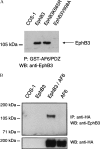PDZ-domain-mediated interaction of the Eph-related receptor tyrosine kinase EphB3 and the ras-binding protein AF6 depends on the kinase activity of the receptor
- PMID: 9707552
- PMCID: PMC21413
- DOI: 10.1073/pnas.95.17.9779
PDZ-domain-mediated interaction of the Eph-related receptor tyrosine kinase EphB3 and the ras-binding protein AF6 depends on the kinase activity of the receptor
Abstract
Eph-related receptor tyrosine kinases (RTKs) have been implicated in intercellular communication during embryonic development. To elucidate their signal transduction pathways, we applied the yeast two-hybrid system. We could demonstrate that the carboxyl termini of the Eph-related RTKs EphA7, EphB2, EphB3, EphB5, and EphB6 interact with the PDZ domain of the ras-binding protein AF6. A mutational analysis revealed that six C-terminal residues of the receptors are involved in binding to the PDZ domain of AF6 in a sequence-specific fashion. Moreover, this PDZ domain also interacts with C-terminal sequences derived from other transmembrane receptors such as neurexins and the Notch ligand Jagged. In contrast to the association of EphB3 to the PDZ domain of AF6, the interaction with full-length AF6 clearly depends on the kinase activity of EphB3, suggesting a regulated mechanism for the PDZ-domain-mediated interaction. These data gave rise to the idea that the binding of AF6 to EphB3 occurs in a cooperative fashion because of synergistic effects involving different epitopes of both proteins. Moreover, in NIH 3T3 and NG108 cells endogenous AF6 is phosphorylated specifically by EphB3 and EphB2 in a ligand-dependent fashion. Our observations add the PDZ domain to the group of conserved protein modules such as Src-homology-2 (SH2) and phosphotyrosine-binding (PTB) domains that regulate signal transduction through their ability to mediate the interaction with RTKs.
Figures





Similar articles
-
RYK, a catalytically inactive receptor tyrosine kinase, associates with EphB2 and EphB3 but does not interact with AF-6.J Biol Chem. 2002 Jun 21;277(25):23037-43. doi: 10.1074/jbc.M202486200. Epub 2002 Apr 15. J Biol Chem. 2002. PMID: 11956217
-
The junction-associated protein AF-6 interacts and clusters with specific Eph receptor tyrosine kinases at specialized sites of cell-cell contact in the brain.J Cell Biol. 1999 Jan 25;144(2):361-71. doi: 10.1083/jcb.144.2.361. J Cell Biol. 1999. PMID: 9922461 Free PMC article.
-
Self-association mediated by the Ras association 1 domain of AF6 activates the oncogenic potential of MLL-AF6.Blood. 2010 Jul 8;116(1):63-70. doi: 10.1182/blood-2009-09-243386. Epub 2010 Apr 15. Blood. 2010. PMID: 20395419 Free PMC article.
-
The PTB domain: a new protein module implicated in signal transduction.Trends Biochem Sci. 1995 Jul;20(7):277-80. doi: 10.1016/s0968-0004(00)89043-x. Trends Biochem Sci. 1995. PMID: 7545337 Review.
-
Regulation and targets of receptor tyrosine kinases.Eur J Cancer. 2002 Sep;38 Suppl 5:S3-10. doi: 10.1016/s0959-8049(02)80597-4. Eur J Cancer. 2002. PMID: 12528767 Review.
Cited by
-
The Roles of EphB2 in Cancer.Front Cell Dev Biol. 2022 Feb 10;10:788587. doi: 10.3389/fcell.2022.788587. eCollection 2022. Front Cell Dev Biol. 2022. PMID: 35223830 Free PMC article. Review.
-
PDZ domains: fundamental building blocks in the organization of protein complexes at the plasma membrane.J Clin Invest. 1999 Mar;103(6):767-72. doi: 10.1172/JCI6509. J Clin Invest. 1999. PMID: 10079096 Free PMC article. Review. No abstract available.
-
Eph/ephrin signaling in epithelial development and homeostasis.Int J Biochem Cell Biol. 2009 Apr;41(4):762-70. doi: 10.1016/j.biocel.2008.07.019. Epub 2008 Aug 9. Int J Biochem Cell Biol. 2009. PMID: 18761422 Free PMC article. Review.
-
Cell adhesion, the backbone of the synapse: "vertebrate" and "invertebrate" perspectives.Cold Spring Harb Perspect Biol. 2009 Oct;1(4):a003079. doi: 10.1101/cshperspect.a003079. Cold Spring Harb Perspect Biol. 2009. PMID: 20066100 Free PMC article. Review.
-
Minding the gaps to promote thrombus growth and stability.J Clin Invest. 2005 Dec;115(12):3385-92. doi: 10.1172/JCI26869. J Clin Invest. 2005. PMID: 16322784 Free PMC article. Review.
References
-
- van der Geer P, Hunter T, Lindberg R A. Annu Rev Cell Biol. 1994;10:251–337. - PubMed
-
- Pawson T. Nature (London) 1995;373:573–580. - PubMed
-
- Böhme B, Holtrich U, Wolf G, Luzius H, Grzeschik K H, Strebhardt K, Rübsamen-Waigmann H. Oncogene. 1993;8:2857–2862. - PubMed
-
- Eph Nomenclature Committee. Cell. 1997;90:403–404. - PubMed
-
- Böhme B, VandenBos T, Cerretti D P, Park L S, Holtrich U, Rübsamen-Waigmann H, Strebhardt K. J Biol Chem. 1996;271:24747–24752. - PubMed
Publication types
MeSH terms
Substances
LinkOut - more resources
Full Text Sources
Other Literature Sources
Molecular Biology Databases
Miscellaneous

